The aim of the research of this present work is to answer which criteria make an AI-driven CRM successful, what opportunities and challenges there are, and how the general population assesses this topic. Furthermore, it is important to see that the corona pandemic is having an impact on the use of AI. For this purpose, the following two research questions were asked. How does AI strengthen the customer relationship CRM? Will the Corona pandemic accelerate the use of AI?
To answer the research questions, a quantitative study on people's current opinions and attitudes towards AI and how it will change as a part of the outbreak of the pandemic was conducted. Specifically, the study deals with artificial intelligence in customer service, the change of AI in companies due to Covid-19 and how people generally view the topic of AI. The participants surveyed were anonymous, of different age groups, occupations, and origins, as this topic affects everyone today and it is important to pay attention to the opinion of the general population.
The targeted use of artificial intelligence in customer relationship management to make the work of companies and their employees more efficient and of higher quality, also about the customer, is on the rise. More and more sales are generated by this technology and more and more AI-controlled tools are being developed which make customer management more successful and thus intensify the relationship between customers and companies. Thus, it is necessary to understand such technologies and how they are designed, but also what opinion the general society has on this rather revolutionary technology.
Inhaltsverzeichnis
- CHAPTER 1: INTRODUCTION
- 1.1 RESEARCH BACKGROUND
- 1.2 RESEARCH PROBLEM
- 1.3 RESEARCH QUESTION
- 1.4 STRUCTURE OF THE WORK
- CHAPTER 2: LITERATURE REVIEW
- 2.1 ARTIFICIAL INTELLIGENCE
- 2.2 BIG DATA
- 2.3 MACHINE LEARNING
- 2.4 DEEP LEARNING
- 2.5 CUSTOMER-RELATIONSHIP-MANAGEMENT (CRM)
- 2.5.1 ANALYTICAL CRM
- 2.5.2 OPERATIONAL CRM
- 2.5.3 COLLABORATIVE CRM
- 2.6 COVID-19
- CHAPTER 3: ARTIFICIAL INTELLIGENCE IN THE CUSTOMER RELATIONSHIP MANAGEMENT
- 3.1 MAIN ARTIFICIAL INTELLIGENCE TECHNOLOGIES USED IN THE CRM
- 3.2 EXPLANATION OF AI-ENABLED CRM-SYSTEMS IN SALES
- 3.1.1 EXAMPLE OF AI-POWERED CRM SYSTEMS FOR SALES
- 3.1.2 SALESFORCE
- 3.2 AI-POWERED MARKETING DEPARTMENT
- 3.2.1 CHATBOTS IN MARKETING
- 3.2.2 INTELLIGENT CHATBOTS
- 3.2.3 EXAMPLES FOR CHATBOTS
- CHAPTER 4: BENEFITS AND CRITICS OF COMBINING ARTIFICIAL INTELLIGENCE WITH CRM
- 4.1 BENEFITS OF AI
- 4.2 THREATS AND CHALLENGES OF ARTIFICIAL INTELLIGENCE
- CHAPTER 5: THE FUTURE OF AI
- 5.1 THE FUTURE OF AI IN THE CRM SECTOR
- 5.2 THE SITUATION IN RELATION TO THE COVID-19 PANDEMIC
- 5.3 RESEARCH INTEREST
- CHAPTER 6: RESEARCH METHODOLOGY
- 6.1 METHODOLOGICAL APPROACH AND RESEARCH METHOD
- 6.2 RESULTS
- 6.3 ANSWERING THE HYPOTHESES AND THE RESEARCH QUESTIONS
- 6.4 SUMMARIZING THE HYPOTHESES AND ANSWERING THE RESEARCH QUESTIONS
- CHAPTER 7: DISCUSSION
- 7.1 LIMITATION AND FUTURE RESEARCH
Zielsetzung und Themenschwerpunkte
Die Masterarbeit untersucht die Rolle der künstlichen Intelligenz (KI) im Customer Relationship Management (CRM) und analysiert die Auswirkungen der COVID-19-Pandemie auf die Einführung und Akzeptanz von KI-gestützten CRM-Lösungen. Die Arbeit zielt darauf ab, die Kriterien für einen erfolgreichen Einsatz von KI im CRM zu identifizieren und die Chancen und Herausforderungen zu bewerten, die mit der Integration von KI in CRM-Systeme verbunden sind. Darüber hinaus untersucht die Arbeit die öffentliche Meinung zur KI im CRM-Kontext.
- Der Einfluss von KI auf die Effizienz und Qualität des CRM
- Die Chancen und Risiken von KI im CRM-Bereich
- Die öffentliche Meinung zur KI und deren Einsatz im CRM
- Der Einfluss der COVID-19-Pandemie auf die Einführung und Akzeptanz von KI-gestützten CRM-Systemen
- Die zukünftige Entwicklung von KI im CRM-Sektor
Zusammenfassung der Kapitel
- Kapitel 1: Introduction: Dieses Kapitel liefert einen Überblick über den Forschungsbereich, das Forschungsproblem, die Forschungsfrage und die Struktur der Arbeit.
- Kapitel 2: Literatur Review: Dieses Kapitel beleuchtet die wichtigsten Konzepte, die in der Arbeit untersucht werden, darunter Künstliche Intelligenz, Big Data, Machine Learning, Deep Learning und Customer Relationship Management (CRM).
- Kapitel 3: Artificial Intelligence in the Customer Relationship Management: Dieses Kapitel befasst sich mit der Verwendung von KI-Technologien in CRM-Systemen, insbesondere in den Bereichen Vertrieb und Marketing.
- Kapitel 4: Benefits and Critics of Combining Artificial Intelligence with CRM: Dieses Kapitel beleuchtet die Vorteile und Herausforderungen der Integration von KI in CRM-Systeme.
- Kapitel 5: The Future of AI: Dieses Kapitel analysiert die zukünftige Entwicklung von KI im CRM-Sektor und untersucht die Auswirkungen der COVID-19-Pandemie auf diesen Bereich.
- Kapitel 6: Research Methodology: Dieses Kapitel beschreibt die methodische Vorgehensweise der Arbeit, die Datenerhebung und -analyse sowie die Beantwortung der Forschungsfragen.
Schlüsselwörter
Künstliche Intelligenz, Customer Relationship Management (CRM), AI-gestütztes CRM, Big Data, Machine Learning, Deep Learning, COVID-19-Pandemie, öffentliche Meinung, Effizienz, Qualität, Chancen, Risiken, zukünftige Entwicklungen.
- Quote paper
- Leonard Rupperti (Author), Artificial Intelligence as an Additional Tool in Customer Relationship Management and the Impact after the COVID-19 Crisis, Munich, GRIN Verlag, https://www.grin.com/document/1282733



